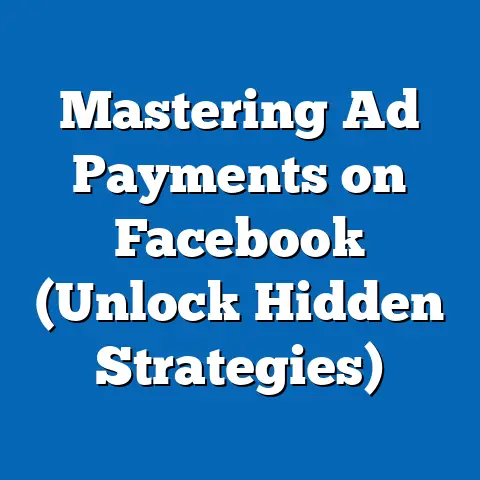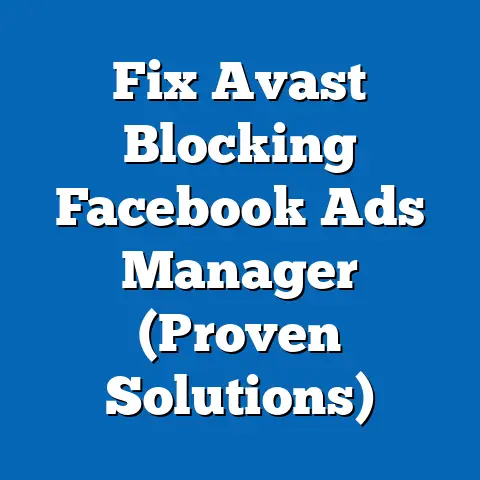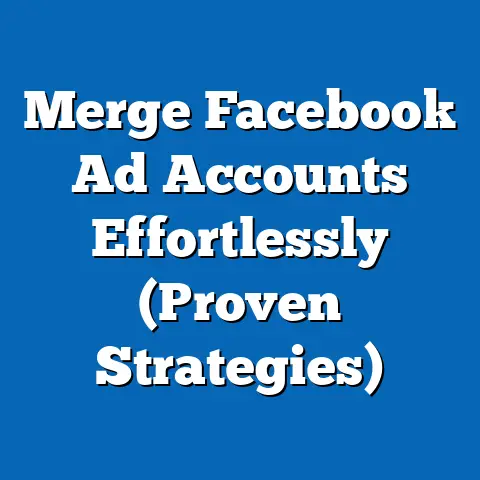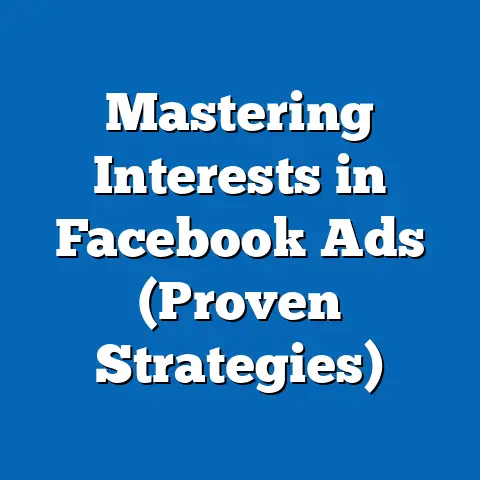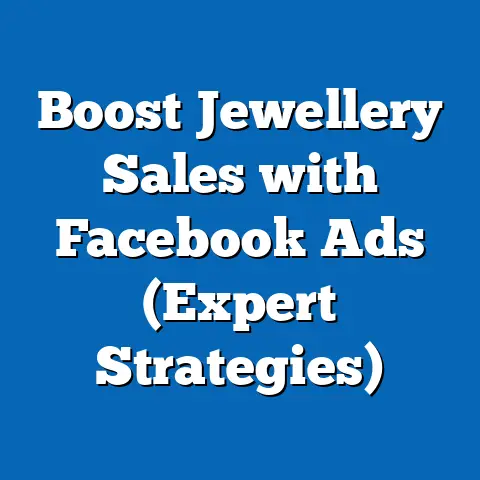Unlock Winning Interests for Facebook Ads (Expert Strategies)
The Facebook advertising landscape is a constantly shifting battlefield. One wrong move, one poorly targeted ad, and your budget can vanish faster than you can say “return on investment.” The truth is, simply having a great product or service isn’t enough anymore. Without a laser-like focus on your audience, specifically understanding and leveraging the right interests, you’re essentially throwing money into the digital abyss. Identifying and targeting those winning interests is the key to unlocking higher engagement, lower costs, and ultimately, a profitable advertising campaign.
Interests, in the context of Facebook Ads, are the specific topics, hobbies, activities, and brands that users have expressed interest in through their behavior on the platform. This includes liking pages, joining groups, engaging with content, and even the information they provide in their profiles. These interests form the foundation for targeted advertising, allowing you to reach individuals who are more likely to be receptive to your message. Think of it as finding the right fishing hole; instead of casting your net randomly, you’re targeting a pond teeming with the exact type of fish you’re after. In this guide, I’ll share my strategies for finding those winning interests so you can maximize your ad performance and achieve your business goals.
The Importance of Targeting Interests
Why should you care about interests in Facebook advertising? Let me paint a picture. Imagine you’re selling high-end organic coffee beans. You could broadly target “coffee lovers,” which is a start. But what if you could target “organic coffee enthusiasts,” “specialty coffee brewers,” or even people who like specific brands of high-end coffee grinders? Suddenly, your ad is reaching a much more qualified audience, those actively seeking the very product you’re offering.
The impact of well-targeted interests is profound. Studies have shown that ads targeted based on interests have significantly higher engagement rates. A study by Facebook themselves demonstrated that interest-based targeting can increase click-through rates (CTR) by as much as 20%. I’ve seen this firsthand. Early in my career, I ran a campaign for a local bookstore. Initially, we targeted broadly – “book lovers” in the city. The results were mediocre. But when we refined our targeting to include interests like “historical fiction,” “science fiction,” and even specific authors, our engagement skyrocketed, and our cost-per-click (CPC) plummeted by 40%.
This brings me to the crucial difference between broad targeting and interest-based targeting. Broad targeting casts a wide net, hoping to catch anyone who might be remotely interested in your product. It’s like shouting into a crowded stadium and hoping someone hears you. Interest-based targeting, on the other hand, is like having a private conversation with someone who’s already interested in what you have to say.
Let me share another example. I worked with a small startup selling eco-friendly cleaning products. They were competing with massive brands with huge advertising budgets. Broad targeting would have been a death sentence. Instead, we focused on interests like “sustainable living,” “zero waste,” “organic gardening,” and even specific environmental organizations. By targeting this niche, we were able to reach a highly engaged audience who were actively looking for eco-friendly alternatives, allowing them to compete effectively and achieve a remarkable return on ad spend (ROAS).
Takeaway: Interest-based targeting is not just a nice-to-have; it’s a necessity for successful Facebook advertising. It allows you to reach a more qualified audience, increase engagement, lower costs, and ultimately, improve your ROAS.
Researching Winning Interests
So, how do you find these elusive “winning interests”? It’s a process that requires a combination of research, analysis, and a bit of creative thinking. Fortunately, Facebook provides several tools and strategies to help you uncover the interests that resonate with your target audience.
1. Facebook Audience Insights: This is your first port of call. Audience Insights provides a wealth of data about the demographics, interests, behaviors, and lifestyles of people on Facebook. You can start by entering a broad interest related to your product or service and then explore the related interests that Facebook suggests.
Here’s how I typically use Audience Insights:
- Start Broad: I begin with a general interest related to my client’s niche. For example, if I’m working with a fitness brand, I might start with “fitness” or “health and wellness.”
- Explore Related Interests: Audience Insights will then display a list of related interests, along with data on the demographics, page likes, location, and activities of people interested in those topics.
- Look for Overlapping Interests: The real magic happens when you identify overlapping interests. For instance, if I see that people interested in “fitness” also tend to be interested in “healthy eating” and “yoga,” I know I’ve found a potential audience segment.
- Analyze Page Likes: Pay close attention to the “Page Likes” section. This shows you the top pages that people interested in your chosen interest also like. This can reveal even more specific and targeted interests.
2. Competitor Analysis: Your competitors are a valuable source of information. By analyzing their ads and audience engagement, you can uncover interests that are already working for them.
Here’s how to conduct a competitor analysis:
- Use the Facebook Ad Library: This is a free tool that allows you to see all the active ads that any page is running on Facebook and Instagram. Search for your competitors and analyze their ad copy, visuals, and targeting.
- Look for Common Themes: Identify the interests that your competitors are targeting. Are they focusing on specific demographics, hobbies, or brands?
- Analyze Engagement: Pay attention to the comments and shares on your competitors’ ads. This can give you insights into what resonates with their audience.
- Reverse Engineer: Use the information you gather to reverse engineer your competitors’ targeting strategy. If they’re successfully targeting a specific interest, it’s likely that it will work for you as well.
3. Social Listening: Monitoring trends on social media platforms can help you identify emerging interests and topics that are gaining traction. This is especially important if you’re targeting younger audiences or niches that are rapidly evolving.
Here’s how to use social listening:
- Use Social Media Monitoring Tools: Tools like Hootsuite, Brandwatch, and Mention allow you to track keywords, hashtags, and mentions related to your industry.
- Monitor Trending Topics: Pay attention to the topics that are trending on social media platforms like Twitter, Instagram, and TikTok.
- Join Relevant Groups and Communities: Participate in online communities related to your niche to learn about the interests and concerns of your target audience.
- Identify Influencers: Look for influencers who are popular within your target audience. Analyzing their content and engagement can give you insights into the interests that resonate with their followers.
Example: Let’s say you’re selling a new line of sustainable activewear. Using Audience Insights, you might start with the interest “yoga.” You then discover that people interested in yoga also tend to be interested in “eco-friendly products,” “sustainable fashion,” and “mindfulness.” By combining these interests, you can create a highly targeted audience segment. You can then use the Ad Library to see what your competitors are doing in the sustainable activewear space, and monitor social media to identify emerging trends in the industry.
Takeaway: Researching winning interests is an ongoing process that requires a combination of data analysis, competitor analysis, and social listening. By using the tools and strategies outlined above, you can uncover the interests that resonate with your target audience and create highly targeted advertising campaigns.
Creating Interest-Based Audience Segments
Once you’ve identified a list of potential interests, the next step is to create audience segments based on those interests. This involves combining interests with other targeting options, such as demographics, behaviors, and location, to create a more refined and targeted audience.
The key here is layering. Don’t just target “coffee lovers.” Target “coffee lovers” who are also interested in “fair trade” and “organic farming” and live in a specific geographic area known for supporting local businesses. The more specific you get, the more likely you are to reach people who are genuinely interested in your product or service.
Here’s how I approach creating interest-based audience segments:
- Start with a Core Interest: Choose the most relevant interest as your starting point. This should be the interest that is most closely related to your product or service.
- Add Demographic Layers: Refine your audience by adding demographic layers such as age, gender, education, and income. This will help you to reach people who are more likely to be your ideal customer.
- Include Behavioral Targeting: Use Facebook’s behavioral targeting options to reach people based on their past behavior on the platform. For example, you can target people who have recently purchased products online, who have traveled recently, or who have shown an interest in specific types of content.
- Consider Location Targeting: If you’re a local business, location targeting is essential. You can target people who live in a specific city, region, or even within a certain radius of your business.
- Use Custom Audiences: Custom Audiences allow you to upload your own customer data, such as email addresses or phone numbers, and target those individuals on Facebook. This is a great way to reach your existing customers with targeted ads.
- Leverage Lookalike Audiences: Lookalike Audiences allow you to create audiences that are similar to your existing customers or website visitors. This is a powerful way to expand your reach and find new customers who are likely to be interested in your product or service.
Example: Let’s say you’re selling a premium online course on digital marketing. You might start by targeting people interested in “digital marketing” and “social media marketing.” You could then add demographic layers such as age (25-45), education (college degree), and income (above average). You could also include behavioral targeting options such as “interested in online learning” and “purchased online courses in the past.” Finally, you could create a Lookalike Audience based on your existing customer list to reach new people who are similar to your current customers.
Takeaway: Creating interest-based audience segments is a crucial step in successful Facebook advertising. By layering interests with other targeting options, you can create highly refined audiences that are more likely to engage with your ads and convert into customers.
Testing and Optimizing Interest Targeting
Creating the perfect audience segment is only half the battle. The other half is testing and optimizing your targeting to ensure that you’re getting the best possible results. This involves A/B testing different interest groups, analyzing performance data, and iterating on your campaigns based on what you learn.
A/B testing is the cornerstone of any successful Facebook advertising strategy. It allows you to compare the performance of different ad variations, targeting options, and bidding strategies to identify what works best for your audience. When it comes to interest targeting, A/B testing is essential for determining which interests are most effective for reaching your target audience.
Here’s how to set up A/B tests for interest targeting:
- Create Multiple Ad Sets: Create multiple ad sets, each targeting a different interest group.
- Keep Everything Else Constant: Ensure that all other variables, such as ad creative, bidding strategy, and placement, are the same across all ad sets.
- Run Your Tests: Run your tests for a sufficient amount of time to gather enough data to make statistically significant conclusions.
- Analyze the Results: Analyze the performance data for each ad set, paying close attention to metrics such as CTR, conversion rate, and cost per acquisition.
- Optimize Your Campaigns: Based on the results of your A/B tests, optimize your campaigns by focusing on the interest groups that are performing the best.
Key metrics to focus on when analyzing the results of your A/B tests include:
- Click-Through Rate (CTR): This measures the percentage of people who see your ad and click on it. A high CTR indicates that your ad is relevant and engaging to your target audience.
- Conversion Rate: This measures the percentage of people who click on your ad and then take a desired action, such as making a purchase or filling out a form. A high conversion rate indicates that your ad is effectively driving conversions.
- Cost Per Acquisition (CPA): This measures the cost of acquiring a new customer. A low CPA indicates that your ad is efficiently driving conversions.
Based on the performance data, you can optimize your campaigns by:
- Scaling Successful Campaigns: Increase the budget for ad sets that are performing well.
- Iterating on Less Successful Campaigns: Adjust the targeting, ad creative, or bidding strategy for ad sets that are underperforming.
- Pausing Underperforming Campaigns: Pause ad sets that are not performing well and focus your budget on the campaigns that are delivering the best results.
Expert Tip: Don’t be afraid to experiment. Try targeting unexpected interests, combining interests in creative ways, and testing different ad creative variations. The more you experiment, the more you’ll learn about what works best for your audience.
Takeaway: Testing and optimizing your interest targeting is an ongoing process that requires a data-driven approach. By A/B testing different interest groups, analyzing performance data, and iterating on your campaigns based on what you learn, you can maximize the effectiveness of your Facebook advertising and achieve your business goals.
Conclusion
Unlocking winning interests for Facebook ads is not just about finding the right keywords; it’s about understanding your audience on a deeper level. It’s about knowing their passions, their hobbies, their aspirations, and their pain points. By using the strategies outlined in this guide, you can uncover the interests that resonate with your target audience and create highly targeted advertising campaigns that drive engagement, conversions, and ultimately, business growth.
The Facebook advertising landscape is constantly evolving, but one thing remains constant: the importance of understanding your audience. By staying informed about the latest trends, experimenting with different targeting options, and continuously optimizing your campaigns, you can stay ahead of the competition and achieve your advertising goals.
Now, I urge you to take action. Experiment with your own interest targeting, try out the strategies I’ve shared, and see what works best for your business. And don’t forget to share your results! The more we learn from each other, the better we can all become at Facebook advertising. So go out there, find those winning interests, and unlock the full potential of your Facebook ad campaigns!

